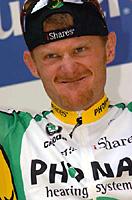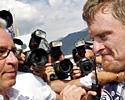News feature, July 28, 2006
Floyd Landis positive: Was it the beer?
Floyd Landis's "adverse analytical finding" for testosterone in stage 17 of the Tour de France sent shock waves round the cycling world. Landis claims he is innocent and plans to defend himself. John Stevenson and Jeff Jones examine the testosterone test and Landis' possible defences.

|
On Wednesday, the UCI announced that a rider at the Tour de France had returned an "adverse analytical finding", indicating the use of performance-enhancing drugs in a stage of the Tour. Yesterday, after the cycling rumour mill had gone into overdrive, the Phonak team announced that rider was race winner Floyd Landis.
The analysis of Landis' A sample from stage 17 of the Tour de France returned an abnormal ratio for the amounts of testosterone to epitestosterone. Testosterone is a naturally occurring hormone which stimulates muscle growth. Epitestosterone is also produced by the body, and while its role is less clear, it is normally present in urine in a ratio of between 1:1 and 3:1 testosterone:epitestosterone (T:E).
That normal range gives the basis for the detection of testosterone use in athletes. A T:E ratio of more than 4:1 is considered a positive test; that ratio was lowered from 6:1 at the beginning of 2006.
Tests for naturally-occurring substances present a problem for anti-doping authorities. The situation with stimulants such as amphetamines and cocaine is simple: there's no way these substances should be in the body, and so any amount of them or their metabolites in a urine sample is considered proof of doping.
But when the substance occurs naturally, anti-doping authorities have to devise a test that detects abnormalities caused by the illegal use of the substance. The problem is that such abnormalities may not be that abnormal after all.
For example, a 1996 study of Swedish athletes[1] analysed 8946 urine samples, and found 28 with T:E ratios higher than 6:1, the ratio used to determine a doping infraction at the time. Researchers concluded that only one of those samples could be regarded as a clear case of testosterone doping.
Over the years, athletes accused of doping after failing a T:E test have attempted to demonstrate, often successfully, that the elevated ratio had a natural cause[2]. In 1999, for example, Santiago Botero was exonerated of using testosterone because his doctor was able to convince authorities that he had a naturally high T:E ratio after he had returned levels well over 6:1. (Unfortunately for Botero, that doctor was Eufemiano Fuentes, the former Kelme team doctor at the centre of the Operacion Puerto blood doping investigation in Spain; Botero's Phonak team benched him in early June when his links with Fuentes were revealed).
Landis is unlikely to rely on that defence, but it may be his only option. He has been tested too many times this year, without problems, to have much chance of claiming he suddenly has a naturally elevated T:E ratio. But it's those previous tests, and especially the ones at the Tour de France, that may help him now.
In 1997 mountain bike racer Paola Pezzo tested positive for Nandrolone at a race in Annecy, France on September 6. Pezzo was eventually cleared because tests of samples she gave on August 30 and September 21 were both negative.
As the race leader, Landis would have been tested after stage 15 of the Tour, and again after regaining the yellow jersey in stage 19. Those tests are not being reported by the anti-doping authorities as positives.
Pezzo relied on evidence from Professor Guido Norbiato of the Faculty Of Endocrinology and Metabolism, Luigi Sacco University Hospital, Milan who claimed that she could have ingested the Nandrolone in meat while in Belgium. Landis will need a convincing explanation of how his T:E ratio came to be elevated on stage 17 of the Tour.

|
The first, and probably weakest, explanation that springs to mind is "Nobody would be dumb enough to dope and then win a stage of the Tour de France by six minutes." Techniques for evading detection are sufficiently well-known that it's not unreasonable to accuse the current anti-doping regime of being an intelligence test. Landis and his staff would know that if he won the stage he would be tested. It's hard to believe that he would take the risk at all; harder still to think that if he did dope, he would do so at a detectable level.
German doctor Kurt Moosburger recently detailed the use of steroids for recovery. "You put a standard testosterone patch that is used for male hormone replacement therapy on your scrotum and leave it there for about six hours," Moosburger told German press agency dpa. "The small dose is not sufficient to produce a positive urine result in the doping test, but the body actually recovers faster."
Recovery during training has been the traditional use for steroids in sport, but Moosburger implies that it could be used during competition as well. However, one Cyclingnews reader who uses testosterone for legitimate medical reasons points out that the technique does have drawbacks. "Androderm patches are useless they fill your body with water and make the legs heavy," he writes. "They will however cause a big stiff painful erection and it lasts for hours. (Me missus loves it)."
However, when he attempted to blame his 2004 EPO positive on contaminated supplements, Belgian rider Dave Bruylandts tried the 'nobody would be dumb enough to dope these days' defence. An unimpressed Belgian cycling federation recommended he be suspended for four years; he eventually copped an 18 month ban.
Two other factors have been shown to elevate T:E levels: alcohol and intense effort. A 1988 study [3] found that ingestion of alcohol could increase the T:E ratio, though the effect is relatively small even for a large amount of alcohol. The subjects ingested between 110-160 g of ethanol (2 g/kg bodyweight), and researchers found that it "increased the ratio between testosterone and epitestosterone in urine from 1.14 +/- 0.07 to 1.52 +/- 0.09 in four healthy male volunteers. The increase ranged from 30% to 90% in the different subjects studied (mean 41%)."
Landis was quoted at the time as saying that he'd only had one beer and a small amount of Jack Daniels later on. Even a pint of normal strength beer generally doesn't contain more than 20 g of alcohol, while a shot of whiskey contains about 10 g - a much lower level than was studied by the Swedish researchers.

|
Certain types of intense effort have also been shown to increase the T:E ratio[4]. It's hard to imagine a more intense effort than Landis' extraordinary escape in stage 17, but the studies that found high T:E after intense effort refer to the kinds of workout undertaken by bodybuilders. It's not clear whether these findings translate to hours-long aerobic efforts, where strength plays a small part in performance.
It's important to note that the above explanations have not been put forward by the Landis camp, but mostly by fans who desperately want to believe that Landis' stage 17 ride and his subsequent Tour de France victory was "real". Landis probably knows that if his B sample is positive, then he'll need something stronger than the above to convince the US Anti-Doping Association that he did not take exogenous testosterone to help him recover after stage 16.
[1] Increased urinary testosterone/epitestosterone ratios found
in Swedish athletes in connection with a national control program. Evaluation
of 28 cases.
Garle M, Ocka R, Palonek E, Bjorkhem I. - J Chromatogr B Biomed Appl. 1996 Dec
6;687(1):55-9. www.ncbi.nlm.nih.gov/entrez/query.fcgi?db=pubmed&cmd=Retrieve&dopt=AbstractPlus&list_uids=9001952&query_hl=3&itool=pubmed_DocSum
[2] Performance Characteristics of a Carbon Isotope Ratio Method
for Detecting Doping with Testosterone Based on Urine Diols: Controls and Athletes
with Elevated Testosterone/Epitestosterone Ratios
Aguilera, R., Chapman, T. E., Starcevic, B., Hatton, C. K., and Catlin, D. H.
Clin Chem. 2001; 47: 292-300.
www.clinchem.org/cgi/content/full/47/2/292
[3] Effect of ethanol on the ratio between testosterone and
epitestosterone in urine.
Falk O, Palonek E, Bjorkhem I. Clin Chem. 1988 Jul;34(7):1462-4.
www.clinchem.org/cgi/reprint/34/7/1462?ijkey=f5c2e269a70b2808e91787e399f2030aa32cb7a0
[4] Resistance Training Increases Possibility Of A Positive
Drug Test
Kraemer, W. J., & Ratamess, N. A. (2005). Hormonal responses and adaptations
to resistance exercise and training. Sports Medicine, 35, 339-361.
coachsci.sdsu.edu/csa/vol116/kraemer.htm

